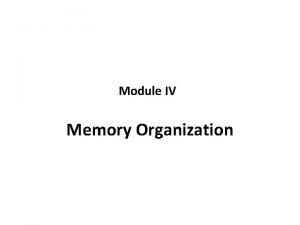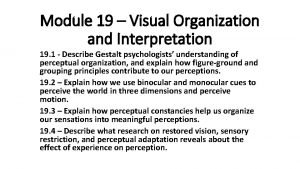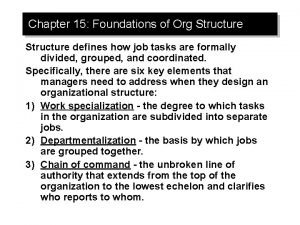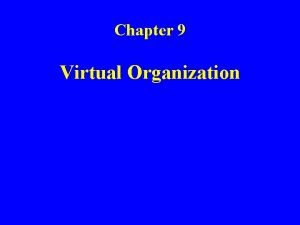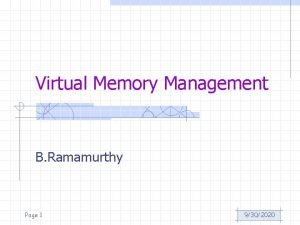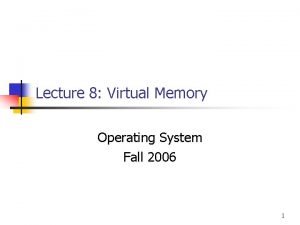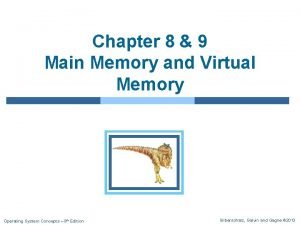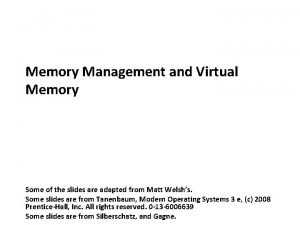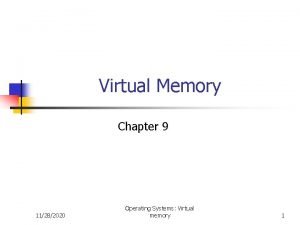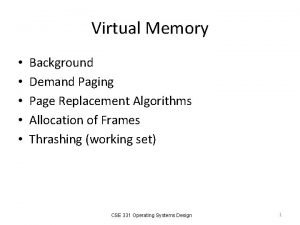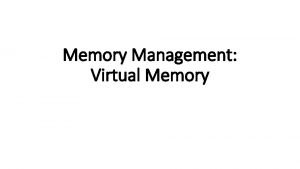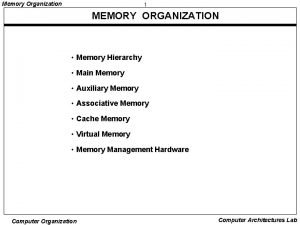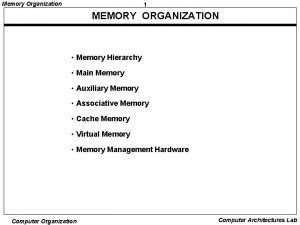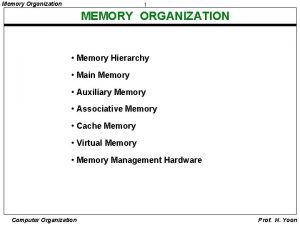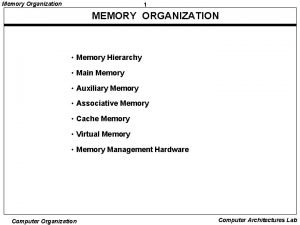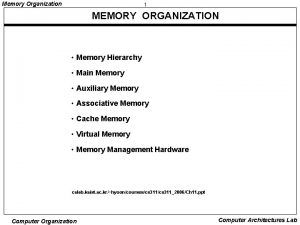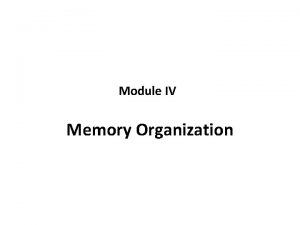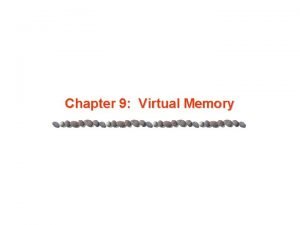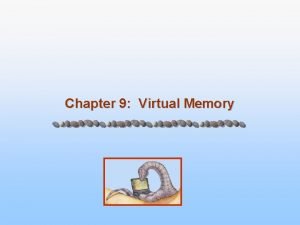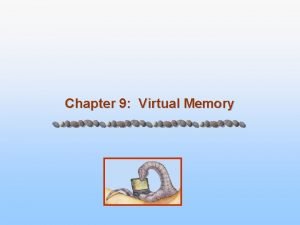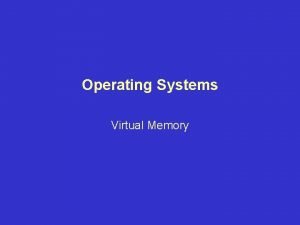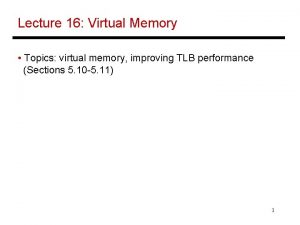Module IV Memory Organization Virtual Memory In a























- Slides: 23

Module IV Memory Organization

Virtual Memory • In a virtual memory system, the OS manages the long pro grams. • User programs can be larger than the physical main memory (2 GB). • OS stores the entire program on a hard disk whose capacity is much larger than the physical memory size.

Virtual Memory • At a given time, only some portions of the program are brought into the main memory from the hard disk. • As and when needed, a portion which is not in main memory is taken from the hard disk, and at the same time, a portion of the program which is present is released out of the main memory and stored on the hard disk. This process is known as swapping. • In a virtual memory system, when a program is executed, swapping is performed as per the require ment on a continuous basis.

Virtual Memory

Virtual Memory • The CPU fetches instruction and data from the main memory. • Whenever the required instruction or data is not present in main memory, the hardware raises an interrupt known as virtual memory interrupt or page fault. • In response, the operating system loads a section of the program (containing the required instruction or data) from the hard disk drive to the main memory. • The page fault occur within an instruction cycle. • After the page fault interrupt is serviced, the CPU will continue processing the partially executed instruction.

Virtual Memory

Advantages of Virtual Memory • Program size is not limited by physical memory size. • User do not have to do memory allocation. Main memory allocation is done automatically according to the demands of the program. • Program can be loaded in any area of physical memory • It allows processes to share files easily.

Virtual Memory • It is implemented using two techniques: – Segmentation – Paging

Segmentation • This memory management technique supports user’s view of memory.

User’s view of a program

Segmentation • Users prefer to view memory as a collection of variable sized segments : – Code : to store program – Data : variables defined by the code are stored – Stack : Used by sub routines and interrupt service routines to hold temporary data and addresses.

Segmentation • All applications need to be loaded into main memory before they can be executed. • In order to do so, a temporary 'segment' is created by the memory manager

A typical segment

Segmentation • There can be many segments in memory at the same time. • Each one is a separate process or application and each may be a different size


Segmentation • Segmentation allows the OS to do is to place each one of those segments in different parts of physical memory.

Segmentation

Segmentation • In segmentation, a memory reference includes a value that identifies a segment (segment number) and an offset within that segment. • A segment is associated with – a flag indicating whether it is present in main memory or not – information indicating where the segment is located in memory(the address of the first location in the segment)(base address) – has a set of permissions – Length

Segmentation • If the segment is not present in main memory, an exception is raised and the OS will read the segment into memory from secondary storage.

Segmentation • If a reference to a location within a segment is made, – Physical address = base address +offset • A memory management unit (MMU) is responsible for – translating a segment and offset (logical address) into a memory address, – checking to make sure the translation can be done and that the reference to that segment and offset is permitted.

Segmentation • The mapping is done with help of segment table. • Logical address consists of two parts: a segment number s, and offset d • s is used as an index to the segment table. • Each entry of segment table has base and limits. – base contains starting physical address where resides in memory – limit specifies length of the segments • d must be between 0 and the segment limit. If not, it traps to addressing error • If offset is valid, it is added to base to produce physical address

Segmentation: Hardware

E X A M P L E
 Virtual memory organization
Virtual memory organization Page fault
Page fault Virtual memory in memory hierarchy consists of
Virtual memory in memory hierarchy consists of C device module module 1
C device module module 1 Visual organization and interpretation
Visual organization and interpretation Fundamental truth underlying all of the gestalt principles
Fundamental truth underlying all of the gestalt principles Has virtual functions and accessible non-virtual destructor
Has virtual functions and accessible non-virtual destructor Coa virtual lab iit kharagpur
Coa virtual lab iit kharagpur Virtual organization structure
Virtual organization structure Elements of organizational structure
Elements of organizational structure Nike virtual organization
Nike virtual organization Process organization in computer organization
Process organization in computer organization Point by point vs block organization
Point by point vs block organization Virtual memory
Virtual memory Aging algorithm
Aging algorithm Virtual memory in os
Virtual memory in os Virtual memory in os
Virtual memory in os Virtual memory advantages
Virtual memory advantages Explain virtual memory in computer architecture
Explain virtual memory in computer architecture Demand paging in virtual memory
Demand paging in virtual memory Virtual memory in os
Virtual memory in os Multilevel page tables
Multilevel page tables Virtual memory os
Virtual memory os Virtual memory
Virtual memory
